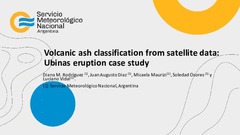Volcanic ash classification from satellite data: Ubinas eruption case study
Autores

Resumen
The dispersion of volcanic ash in the atmosphere, caused by eruptions or resuspension, is a threat to aviation. Volcanic Ash Advisory Centers (VAACs) monitor and track volcanic clouds through remote sensing and forecast the dispersion and report them through Volcanic Ash Advisories (VAA). In the next years, there will be a major shift in the production of VAACs, with the introduction of Quantitative Volcanic Ash Information (QVA). QVA will allow users to make decisions based on ensemble-based forecasts of ash concentration. To provide a quality product, it is necessary to verify them using observed data. The proper detectiodifferencessification of volcanic ash in the atmosphere using remote sensing data will allow the verification of modeled ash mass loading results, using the the discernible ash threshold as a first step, and subsequently against the satellite estimations of ash mass loading. In this work, different methodologies are studied to classify scenes with volcanic ash, based on brightness temperature differences using 2, 3, and 5 infrared bands, from the ABI sensor aboard the GOES-16 satellite and the VIIRS sensor aboard the NOAA-20 satellite. The eruption of the Ubinas Volcano in Perú on July 19, 2019, is taken as a case study. The results of this work will contribute to the development of the QVA information verification system for the Buenos Aires VAAC.
Colecciones
Fecha
2023-12Metadatos
Mostrar el registro completo del ítemUtilice este identificador (URI) para citar o enlazar este item
http://hdl.handle.net/20.500.12160/2655El ítem tiene asociados los siguientes ficheros de licencia: